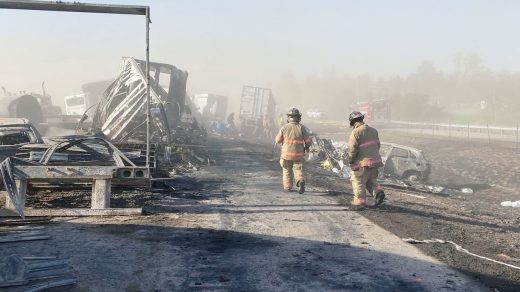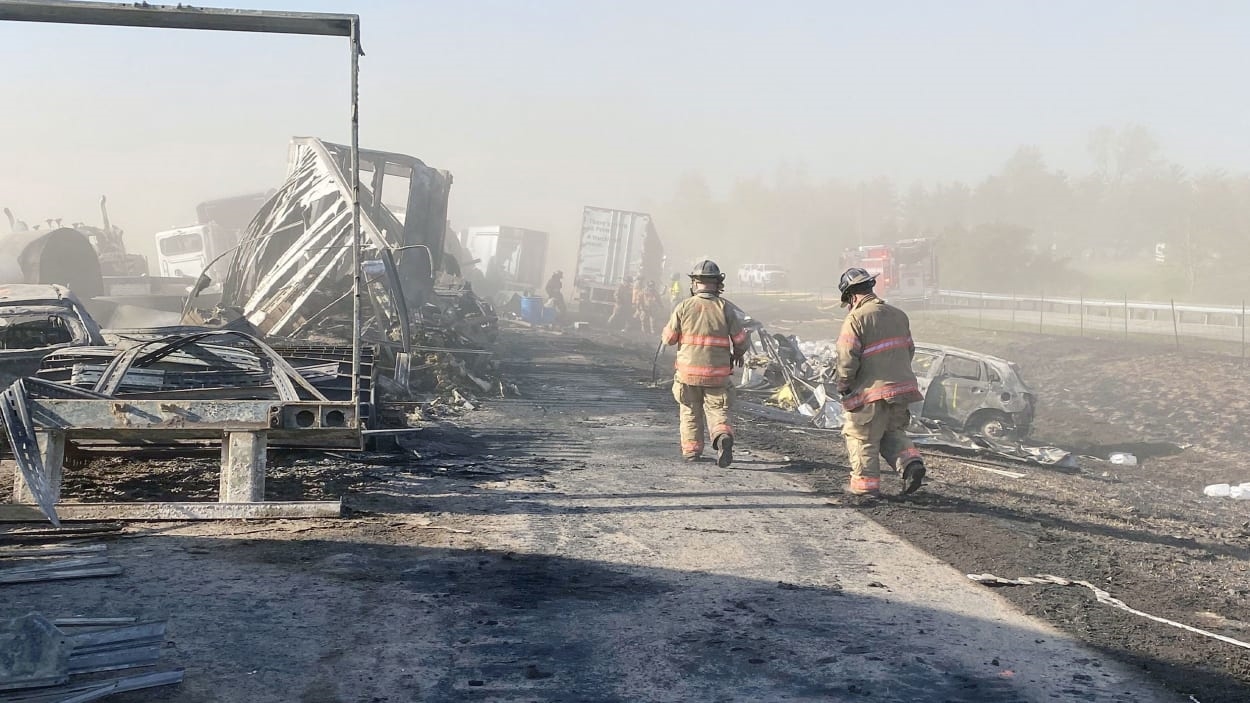Industrial farming may be to blame for a freak dust storm that caused a deadly car pileup
On Monday, a dust storm caused by wind whipping over newly plowed fields caused a 72-car pileup outside of Springfield, Illinois, which authorities now say has killed six people and left three dozen hospitalized, from ages 2 to 80.
Drivers described watching a cloud overtake the highway in zero visibility. Some cars swerved in panic, others braked abruptly, while others just careened into the nearby cars, all resulting in utter chaos.
Police had to shut traffic down on I-55 for 30 miles—the road finally reopened Tuesday—but authorities couldn’t close it before social media exploded with videos that made central Illinois look like an apocalyptic wasteland:
Videos posted to Twitter show vehicles enveloped in a thick white haze with the silhouettes in the distance of 18-wheelers turned sideways and hoods billowing smoke. Illinois police said visibility was reduced to where drivers couldn’t see past their own hoods. News reports say that 10 helicopters arrived on the scene, somehow, and emergency vehicles brought in hazmat teams to suppress the car fires.
It is Illinois’s worst traffic accident caused by a dust storm, and it drew a fast statement from Governor J.B. Pritzker, who described it as “horrific.” Naturally, it has also left people wondering what caused the freak incident, and authorities are giving them an explanation that may sound extremely fixable.
“The cause of the crash is due to excessive winds blowing dirt from farm fields across the highway leading to zero visibility,” Illinois police said in their news release.
“The farmers are out there tilling their fields and planting,” National Weather Service meteorologist Chuck Schaffer told the Associated Press. “The top layer of soil is quite loose.”
“The deciding factor today was the tilled fields,” CNN meteorologist Chad Myers said. “This was a localized event by localized conditions.”
Dust storms—a common sight in the Southwest where it’s dry and sandy—are actually rare in Illinois. In fact, meteorologist Jacob Dickey from Illinois station WCIA says this region has only seen three dust storms this serious before: one in 1983, another in 1990, and a third in 2017. Excessively dry ground (the area got half the average rainfall during the month of April) plus 40-mile-an-hour wind gusts on Monday created the awful whiteout-style conditions.
Pointing the finger at Big Ag
Of course, humans have little control over the wind speed or amount of precipitation that falls from the sky. Yet, as agriculture experts watching this tragedy unfold have begun to note, humans do get to choose which farming techniques they use.
Tilling is a centuries-old technique that can effectively loosen and aerate the soil and kill weeds. But critics of industrial farming say that in the hands of Big Ag (via powerful modern tractors), the practice has deleterious effects on the land, from drying out the soil, depleting the nutrients, killing earthworms and other beneficial microbes, and causing chemical runoff.
Their argument is, if America wants to avoid a future of freak dust storms like these, agriculture needs to embrace practices like no-till farming, which is even being cheered lately by people outside of the industry; proponents argue it doesn’t just enrich the soil so crops grow better, but also sequesters carbon in the ground, helping to mitigate climate change.
This technique curbs soil erosion, especially if soil is dry or sandy. As it happens, Illinois mostly has Drummer soil—a fine-silty type of soil described as feeling like flour when dry. It’s so common statewide, it was declared Illinois’s official soil in 2001.
The most common crops found in Illinois’ Drummer soil are corn and soybeans, large-scale crops that grow very well in Illinois and appear there in giant monocultures. (“Illinois counties produced more corn and soybeans than anywhere else in the nation,” Governor Pritzker bragged in a news release a month ago, after the USDA released new U.S. ag production figures, adding: “When we say Illinois farmers do it best, this is what we mean.”)
But critics like Dave Brandt, a soil-health guru who’s led no-till workshops for the USDA, argue the problem with monocultures is that nature doesn’t mono-crop, so farming that way creates extenuating circumstances. Brandt and Mitch Hora, CEO of the soil-health startup Continuum Ag, both appear worked up over Illinois’s dust storm.
A group on #AgTwitter have spent the last 24 hours in a pile-on over the storm.
“Sickening, frustrating, maddening,” Paul Overby, a regenerative farmer in North Dakota, wrote. “We know how to farm so this doesn’t happen. Some just choose not to do it.”
Jordan Hedberg, a Colorado rancher and newspaper publisher, added: “All this for low quality and tax-payer funded corn ethanol gasoline.”
“Multiple fatalities,” University of Iowa ag researcher and podcaster Chris Jones tweeted, “but thank god farmers have the freedom to farm the way they want so we don’t all starve to death.”
(7)



